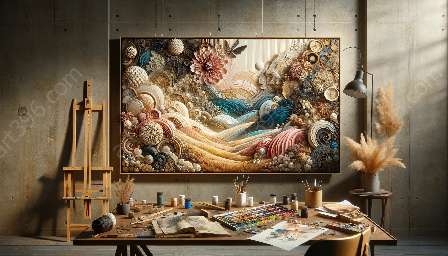Mixed media art is a diverse and dynamic form of artistic expression that involves the use of various materials and techniques to create compelling and unconventional artworks. As a result of its unique and often unconventional combination of materials, preserving and displaying mixed media art presents unique challenges and opportunities.
This topic cluster will explore the principles and elements of mixed media art, as well as the best practices for preserving and displaying such artworks in a way that honors and enhances their inherent qualities.
Principles and Elements of Mixed Media Art
Mixed media art incorporates a wide range of materials and techniques, including but not limited to paint, paper, fabric, found objects, digital elements, and more. The principles and elements of mixed media art provide a framework for understanding and creating within this versatile and expressive medium.
Principles
The principles of mixed media art emphasize experimentation, juxtaposition, and layering. Artists often explore the interplay of textures, shapes, colors, and patterns to create visually stimulating and emotionally evocative compositions. Additionally, mixed media art often encourages the use of unconventional materials and techniques, challenging traditional notions of artistic expression.
Elements
In mixed media art, the elements encompass a wide variety of materials and techniques, including but not limited to:
- Texture: Incorporating a variety of textures adds tactile interest and depth to mixed media artworks.
- Layering: Layering different materials and images creates visual depth and complexity within the artwork.
- Collage: Assemblage and collage techniques allow artists to combine disparate elements into a cohesive composition.
- Color: The use of color, whether bold and vibrant or muted and understated, is a crucial element in mixed media art.
- Imagery: Incorporating photographs, prints, or other visual elements adds depth and narrative to mixed media artworks.
Preservation of Mixed Media Art
Preserving mixed media art involves protecting the various materials and components used in the artwork while maintaining the artist's intended aesthetic and conceptual vision. The multifaceted nature of mixed media art presents unique considerations for preservation strategies:
- Protective framing: Proper framing and glazing can help shield mixed media artworks from dust, moisture, and physical damage, while also enhancing their visual impact.
- Conservation-grade materials: Using archival-quality materials, including adhesives, substrates, and protective coatings, is essential for ensuring the longevity of mixed media artworks.
- Environmental control: Proper environmental conditions, including temperature, humidity, and lighting, are critical for preserving the stability and integrity of mixed media artworks.
- Documentation and maintenance: Detailed documentation of materials, techniques, and exhibition history, along with regular maintenance and conservation, are vital for the long-term preservation of mixed media art.
Display of Mixed Media Art
The display of mixed media art involves engaging viewers with the multidimensional and tactile qualities of the artwork, while also highlighting the artist's creative process and intent. Effective display strategies for mixed media art include:
- Interactive viewing: Encouraging tactile exploration and interactive engagement can enrich the viewer's experience of mixed media art, fostering a deeper connection with the artwork.
- Dynamic installation: Experimenting with unconventional hanging or mounting methods, as well as incorporating sculptural elements, can bring a sense of dynamism and depth to the display of mixed media art.
- Contextual narrative: Providing contextual information and insights into the artist's inspiration, process, and intent can enhance viewers' understanding and appreciation of mixed media artworks.
- Varied lighting effects: Thoughtful lighting design can accentuate the textures, layers, and details within mixed media artworks, creating dynamic visual experiences for viewers.
Conclusion
Preserving and displaying mixed media art requires a nuanced understanding of the medium's principles and elements, as well as a thoughtful approach to conservation and presentation. By embracing the experimental and multifaceted nature of mixed media art, artists, collectors, and curators can showcase these compelling artworks in ways that honor their complexity and captivate audiences.

